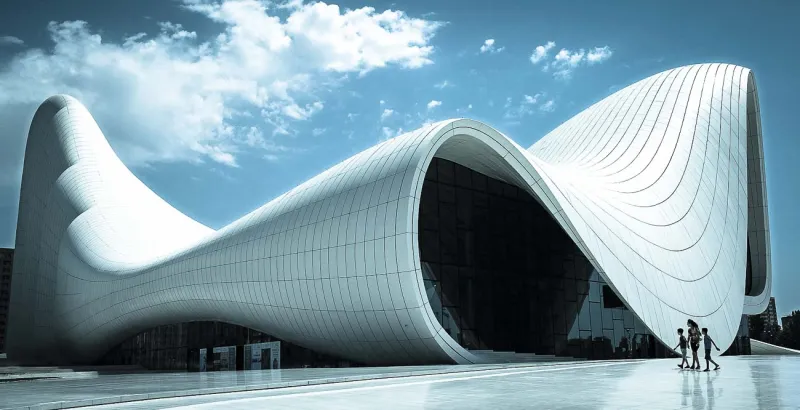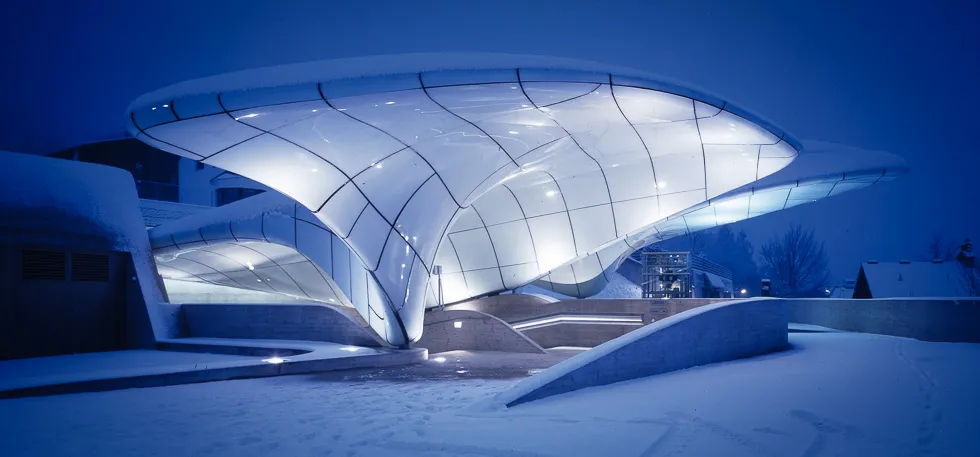Architecture, or zodchestvo, is the art of creating structures that form a spatial environment for human life and activity. At the same time, the construction of buildings must meet the spiritual needs of humanity, influence its aesthetic taste
It should be noted that architecture forms ensembles of buildings, avenues, streets, town squares, garden and park complexes. In the art of architecture, three main types are distinguished:
Architecture of three-dimensional buildings, which includes residential, public and industrial buildings.
Landscape architecture is connected with the creation of a garden and park complex.
Urban planning, which deals with the planning of new cities, as well as the restoration and renewal of old districts.
Each of the architectural types has its own functional purpose. However, in addition to purely utilitarian needs, architecture simultaneously performs the function of emotional impact, which can be achieved through the use of specific structures, elements, techniques. This includes taking into account the three-dimensional structure of the building, rhythmic and proportional ratio, scale, development of color and texture of building materials, etc.
It should be noted that the art of architecture is in direct connection with the development of science. After all, the construction of architectural structures begins with the purely technical stage of design – the execution of the necessary calculations and drawings.
The use of all the means possessed by this type of art leads to the creation of an architectural image. At the same time, the shape, size, color and decoration of the building, which is determined by the specifics and purpose of the architectural structure, must be taken into account. Yes, some houses make a majestic and grandiose impression, others – refined and elegant. Some have a clear symmetrical design or combine complex various elements.
The architectural image reveals both the individual features of the artist’s style, his worldview and worldview, as well as the specifics of the development of a specific historical period.
Determining the features of architecture, M. V. Lomonosov emphasized that this form of art builds buildings that are comfortable for living, beautiful for the eyes, and durable for a long time.

The first evidence of the origins of the art of architecture reaches us from the depths of centuries. In the prehistoric period, primitive residential buildings began to appear – dugouts, smokehouses, communal and pile buildings, cult buildings, which were later improved. Thus, the process of accumulating construction experience gradually begins, and at the same time, the artistic principle is activated.
From primitive cult kurens, the original builders moved on to complicated architectural forms: menhirs, dolmens, cromlechs. These first cult temples had a more complex construction. Burnt bricks were used for their construction, which testified to the birth of a new stage in the development of civilization. Therefore, architecture has always been closely connected with the history of society, with the development of science and technology, natural and climatic conditions, worldview and worldview of the environment. Architecture was also in close connection with other types of art, in particular with sculpture, painting, decorative art, which testifies to its synthetic nature.
As a form of art, architecture begins to take shape in the ancient cultures of Mesopotamia, Egypt, Babylon, Persia, India, and China. It was directly related to the development of slave ownership. Almost all the structures of these countries – pyramids, temples, ziggurats, stupas, palaces – were built to glorify the power of gods and rulers, and were impressive with their majesty, size and scale.
A new stage in the development of architectural art is connected with the culture of Ancient Greece and went down in history as the beginning of “author’s architecture”.
The worldview of the ancient Greeks was confirmed in their architectural structures, which, unlike the Egyptian and Babylonian ones, did not humiliate a person, but, on the contrary, gave rise to a life-affirming principle and a sense of confidence: the ensemble of the Athenian Kremlin – the Acropolis with its main temple – the Parthenon.
During this period, a specific architectural technique was developed – order, which in Latin means order. There were three of them in ancient Greek architecture: Doric, Ionian and Corinthian. They all had common elements: capital, column, architrave, frieze, cornice and differed only in proportions and decorative finish.
It should be noted that during the construction of one of the temples of the Acropolis, for the first time, instead of columns, female figures were used – caryatids, which supported the ceiling of the temple.
The first theoretical generalizations regarding the specifics of architecture are substantiated in the depths of ancient culture, among which the treatise of the Roman architect Vitruvius “Ten Books on Architecture” should be mentioned.
A new stage in the development of the theory and practice of this art form was associated with the culture of Ancient Rome – the Colosseum, the Pantheon, triumphal arches that reflected the ideas of statehood and military power of the Roman Empire. Ancient Roman architects introduced such important elements as the dome and caissons into architectural art.
It was the architecture of the ancient world that laid the foundation for the further development of this type of art and led to the emergence of an architectural direction – a historically formed set of artistic means and techniques – which was closely related to its time, socio-political situation and determined the volumetric and spatial organization of buildings , proportions, shape, decor.
Byzantine architecture performed the function of a kind of plastic bridge between the architecture of antiquity and the Middle Ages.
Byzantine architecture arose after 330 AD. e. The culture of antiquity had a significant influence on its development, the main principles of which were embodied in the brightest examples of the architectural art of Byzantium. This is a temple. Sof;;’ (532–537) in Constantinople, during the construction of which multi-colored marble and majolica were used; the temple of San Vitale (526–547); a significant number of cathedrals-basiliks and palaces.
The luxurious decoration and rich decor of Byzantine temples made a great impression on believers. This characteristic feature of Byzantium’s architectural art was its prominent feature for a long time and was actively used by the Orthodox Church. Byzantine architecture also had a great influence on the development of this type of art in Bulgaria, Serbia and Ancient Russia.
Architecture of Kyivan Rus. A bright page in the art of architecture is the history of ancient Russian architecture of the 11th century, which is interesting primarily for its religious buildings: temples and monasteries, among which the world-famous Sophia Cathedral deserves special attention. Richly decorated inside with a mosaic panel of Maria Oranta and fresco painting, it is a monument of the Byzantine architectural tradition. It was in this period that the Pechora Monastery was built, and later the St. Michael’s Golden-Domed Cathedral (1108–1113), which had a significant impact on the further development of architectural art in Kyivan Rus.
Medieval architecture is associated with the development of the feudal system and the establishment of the power of religion. It was at this time that the main architectural directions began to take shape. Architecture actually becomes the leading art form of the Middle Ages.
The Gothic style arose in the 12th century. It existed within the boundaries of feudal and religious ideology, was characterized by high artistic and stylistic unity, the predominance of vertical compositions. The Gothic style is widespread in many countries of Western Europe, and Reims Cathedral (France) is considered its vivid example.

The Renaissance is a new direction in the development of the art of architecture. In the countries of Western Europe, the Renaissance focused on the revival of ancient culture (this is what led to its name), formed a humanistic consciousness, tried to harmoniously combine the sensual and intellectual in a person, contributed to the progressive development of artistic culture and art.
The architectural Renaissance was represented primarily by such outstanding artists as Filippo Brunelleschi (1377-1446) – the author of the architectural masterpiece of this period – the Pazzi Chapel; Michelangelo Buonarroti – the creator of the world-famous tomb of Pope Julius II and Andrea Palladio (1508-1580) – an architect who created a large number of various structures in Italy.
XVII – the first half of the XVIII century. associated with the establishment of absolute monarchy in many countries of Western Europe, complex processes of struggle between progressive and reactionary tendencies, which were reflected in the art of architecture. The rapid and vivid process of the development of visual arts led to the need for “improvement” of professional education, and as a result, academies of painting, sculpture and architecture were opened in the countries of Western Europe, primarily in France.
Interesting searches taking place at the turn of the XVII-XVIII centuries. within the framework of architectural art, led to the emergence of several trends, among which Baroque, Rococo and Classicism are the most significant.
Baroque as a direction of architectural art impressed with its pomp, complicated construction, a large number of decorations, contrasting forms, significant emotional saturation. He contributed to the glorification and support of absolutism (the Palace of Versailles in the suburbs of Paris) and the power of the Catholic religion (the Church of Santa Maria delle Vittoria in Rome).
V. Rastrelli, the author of the Winter Palace in St. Petersburg, the Catherine Palace in Tsarskoe Selo, and others, was a prominent representative of Baroque in Russian architecture.
This direction was interesting in the culture and art of Ukraine and stimulated the emergence of the phenomenon of “Ukrainian Baroque”. St. Andrew’s Church in Kyiv (architect V. Rastrelli), Nativity Cathedral in Kozelka (architects A. Kvasov and I. Hryhorovych-Barskyi), Yura Cathedral (architect B. Meretyn) and the Dominican Church (architects M. Urbanik and Ya . de Witte) – both in Lviv, as well as the Mariysky (Tsarsky) and Klovsky palaces in Kyiv (architects V. Rastrelli and P. Neelov), the palace of K. Roeumovsky in Baturyn! (architect C. Cameron).
Rococo is a trend in Western European art of the 18th century, which became a transitional stage from Baroque to classicism. Rococo aesthetic principles were most clearly manifested in architecture and decorative arts. Its characteristic features were compositional asymmetry, sophistication, emphasis on white and gold colors. Architects J.M. Oppenor, G.J. Boffran and others worked within this direction.
Classicism. In the second half of the 18th century the process of gradual transformation of baroque into a new architectural direction begins – classicism, which is characterized by rationalism, a tendency towards complete harmonious forms, monumentality, balanced composition.
